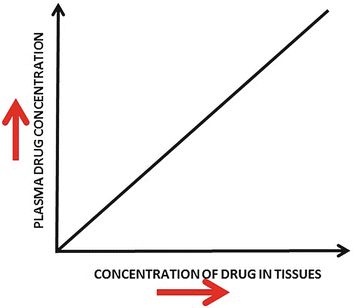Fig. 6.1
Achieving steady state with the use of: (A) a constant infusion (B) intermittent bolus dosing (C) an initial loading dose followed by intermittent doses



Fig. 6.2
Administering intermittent bolus doses of a drug with narrow therapeutic range expose the patient to toxic and ineffective levels during the peak and trough periods respectively
Increasing the frequency of the intermittent administration while reducing the dose can help to reduce the fluctuation and cause it to resemble the practice of an infusion but this is likely to be accompanied with poorer patient compliance in taking the drug.
What Happens When the Infusion Dose or the Intake Is Changed After Steady State Is Achieved
When the dose is changed after achieving steady state, a new steady-state concentration will be achieved after another 4–5 half-lives of the drug. If one wants to achieve the new steady state faster, another loading dose will bring it to the state earlier.
Tissue Concentration Versus the Plasma Concentration at Steady State
The tissue concentration is usually proportional to the plasma concentration (Fig. 6.3) at any one time. The uptake of drugs by different tissues is however different. Some drugs are polar molecules (e.g., gentamicin) and are therefore distributed mainly into extracellular water. Others are fat soluble (e.g., thiopental, diazepam) and distribute more into the fat depots in the body. So at plasma steady state, the various tissues may have reached steady state too, otherwise the plasma concentrations will not continue to be steady. These various tissues will however reach different steady-state concentrations (Fig. 6.4): some higher than that of plasma, others of the same concentration as that of plasma, and yet others at a lower concentration compared to that of plasma.




